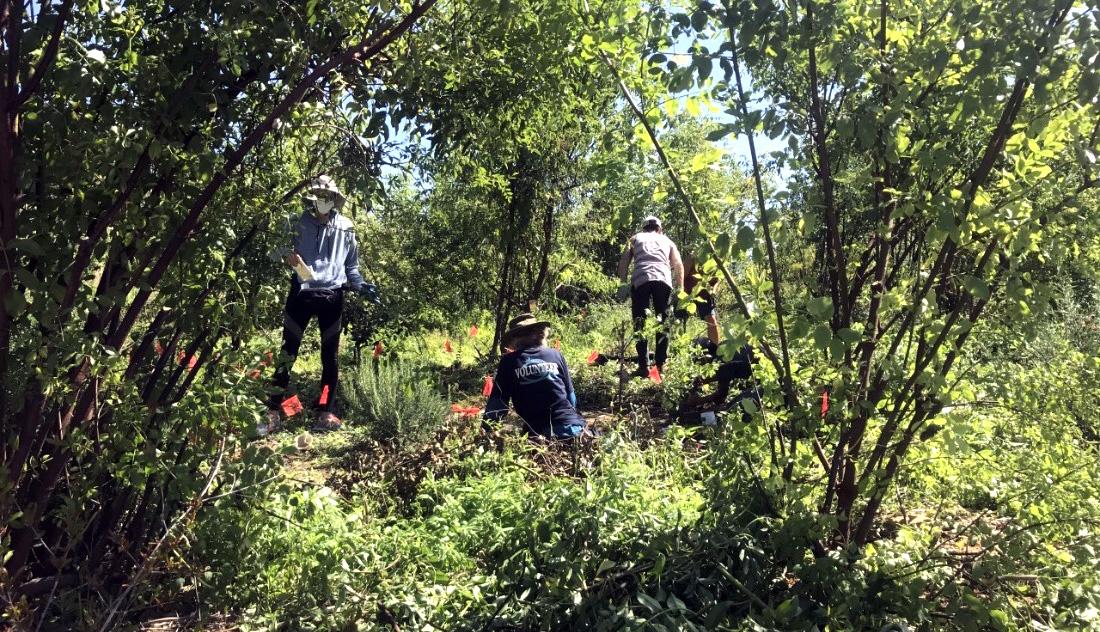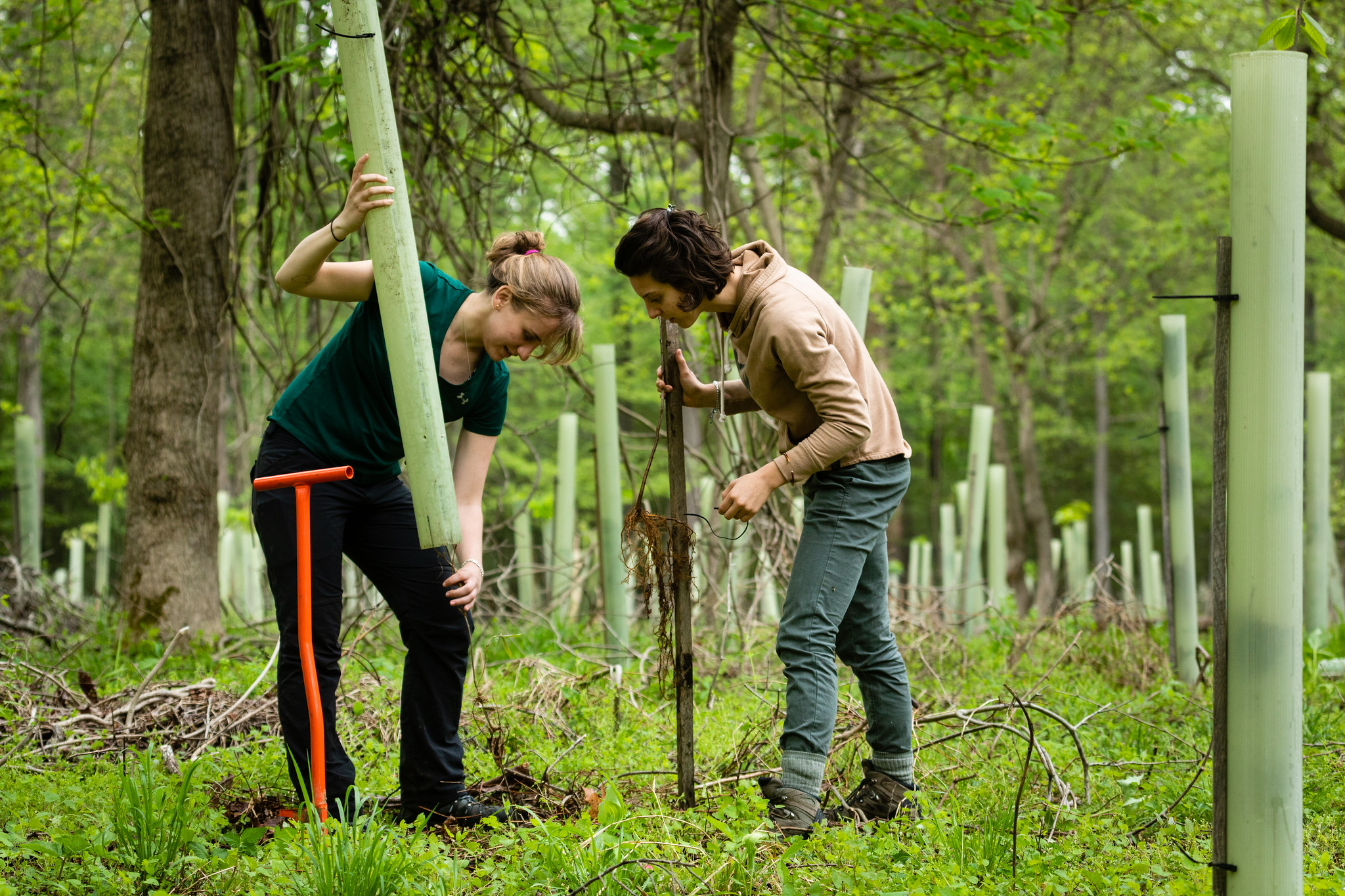Imagine a garden where leaves rustle in the breeze, casting dappled shade over ripe strawberries. Grapevines climb tall fig trees while bright orange butterflies dance in and out of their tendrils. A carpet of oregano covers the ground, releasing a sweet aroma into the cool air.
What seems like a hidden paradise changes when you take a closer look. You see tall buildings peeking out from behind the trees. This is not a remote location. This an agroforestry system right in the middle of a city.
Agroforestry practices involve intentionally integrating trees into agricultural production systems. Farmers and ranchers are increasingly using these practices to produce food in a changing climate, diversify income streams, improve soil health and achieve various other conservation, production and economic goals.
Agroforestry in urban communities
There are many ways and reasons to arrange trees in agroforestry systems, but some of the more common uses in temperate environments are alley cropping, silvopasture, forest farming, riparian forest buffers and windbreaks. Driving down a country road, you may see a single row of trees that serves as a windbreak. Or trees planted between fields and water sources so the tree roots can serve as a filter to protect the water, a practice known as riparian forest buffers.
These same methods can and have been applied in urban settings, including backyards, roadsides, empty lots and public parks. These practices can improve the environment as a whole; they can sequester carbon to help mitigate climate change, provide habitat for biodiversity, improve water quality and more, often while increasing crop productivity. With planning, agroforestry practices also can address urban-specific issues like food insecurity, heat islands, soil contamination, limited wildlife habitat, stormwater runoff and other concerns.
Urban food forests
“Our modern urban landscapes are facing problems, such as the urban heat island effect, a lack of food security in many areas, limited wildlife habitat and more,” said Anne Marsh, director of the USDA National Agroforestry Center. “Agroforestry isn’t new – it comes from Indigenous practices. But it can help us deal with some of these ‘newer’ problems.”
The center researches and provides information about all types of agroforestry systems – big and small. In 2019, the center, with support from the Natural Resources Conservation Service, started a project to develop educational materials showcasing real-life agroforestry systems so that farmers and communities could learn from each other.
The center worked with partners and grant recipients to develop case studies and share information about how they used agroforestry practices. Several highlighted urban agroforestry.
“Our project partners at the National Center for Appropriate Technology visited various urban agroforestry sites and documented their planning, design, management, successes, and challenges,” said Kate MacFarland, agroforester with the National Agroforestry Center and project manager for the Agroforestry Outreach Project.
The sites visited span a wide range of production areas that are using agroforestry to address urban-specific problems.
Nonprofits in Washington, Kansas, Texas and beyond are working with municipalities to plant food forests on public park land, empty lots and roadsides.
Kansas
One such nonprofit, the Lawrence Fruit Tree project, stewards a community food forest on one acre of county land in Lawrence, Kansas. They host a variety of events to bring people together and teach them how to grow their own food, and volunteers and passersby alike are encouraged to harvest from the food forest for free.
“The orchard is like a botanic garden, a learning orchard and an experimental station all in one,” says Skylar Adamson, Lawrence Community Orchard project coordinator. “We plant all different types of plants with the aim of seeing what thrives best here, and volunteers are encouraged to learn and try out new skillsets that they may have not been familiar with before.”
California
Small urban production farms from San Diego, California, to San Antonio, Texas, have incorporated agroforestry practices like windbreaks, silvopasture and alley cropping to maximize their yields in a limited space. Coastal Roots Farm, in San Diego, California, uses a combination of silvopasture and alley cropping in rotation on their urban farm, which allows them to maximize production and produce more than 80,000 pounds of food annually.
“With limited production space here in the city, we have to use every square inch wisely,” says Ellie Honan, Coastal Roots Farm’s grants and impact manager. “By having a layer of overstory.
trees and a layer of understory crops, we are able to take advantage of vertical space and produce more food per square foot.”
Tennessee
An outdoor learning lab in Nashville, Tennessee, called Grow Enrichment teaches nature-based skills to low-income children by using agroforestry. The site practices both forest farming and silvopasture. The trees provide shade and shelter to the crops, animals, and children that spend time below their canopy.
“Our goal is to bring people together and to improve their quality of life,” said Ginger-Rose Kruek, Grow Enrichment’s co-founder and executive director. “And we also want to give children meaningful experiences in nature that allow them to fall in love with it so that when they grow up, they want to protect it.”
Texas
Meanwhile, the City of Austin, Texas, turned a floodplain into a community orchard. The orchard provides a gathering place and a source of food to neighboring communities and also acts as a buffer between the creek and residential areas, helping to preserve wildlife habitat.
“With the City’s resources, and the neighbors’ attention and love, we can see these areas become a wonderful community asset,” said Leah Gibson, conservation program coordinator with the City of Austin’s Watershed Protection Department.
Florida
Over in the Miami-Dade County Public School District, 71 schools planted food forests that serve as outdoor classrooms and spaces where children can connect with nature. The food forests also supply food for the county’s school lunch program, and, to date, more than 230,000 bags of produce grown in the food forests were taken home by students.
Massachusetts
Last, but not least, the Boston Food Forest Coalition created 11 food forests that are owned by the collective in the form of a legal community land trust. The food forests provide free, fresh food to community members and serve as a gathering place where people can learn how to grow food, connect with neighbors, eat together and even laugh.
These examples are just a small glimpse into the many urban and community agroforestry projects happening across the country.
“Urban agroforestry can be implemented in so many different places, and the possibilities are endless,” said Kate MacFarland. “We hope these examples inspire others to see the potential of agroforestry in urban areas.”
Visit the USDA National Agroforestry Center, a Forest Service program, to learn more about how to incorporate these practices into your community.
Learn more about how the Forest Service is investing in urban forests.
Katherine Favor is currently a Climate Hub Fellow with the USDA National Agroforestry Center, a Forest Service program that works in partnership with USDA’s Natural Resources Conservation Service. She previously worked as project manager for the Urban Agroforestry Outreach Project.










